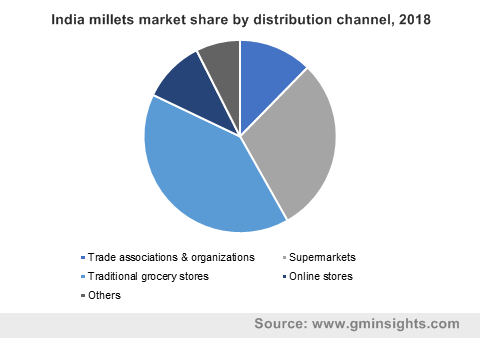Home > Food & Beverages > Processed Food > Convenience Foods > Millets Market
Millets Market Analysis
- Report ID: GMI3370
- Published Date: May 2019
- Report Format: PDF
Millets Market Analysis
Pearl millets accounted for the largest share in millets markets in 2018. The product will be growing with more than 3% CAGR during the forecast duration. The increased share of pearl millet is related to the cultivation and consumption pattern of the region it is grown in. India accounts for highest millets production in terms of volume across the globe. Pearl millets has the highest share in the total millets volume grown in India. Regular millets are grown with help of fertilizers and insecticides. Various regions are adopting organic farm practices to avoid the ill effects of these chemicals. Processers and NGO’s guide farmers in organic farming techniques and process their harvest. Organic millets form an integral part of organic food products bought by consumers who prefer healthy food options. The growing section of such kind of consumer in urban areas of North America, Europe and Asia Pacific will form a lucrative segment for such organic products in the coming years.
Millets based products such as flour, flakes, cookies, etc. are more than ever increasingly visible in consumer market. The high protein content of these grains makes them ideal for vegetarian and vegan population, largely based in the U.S., Europe and Asia Pacific. Breakfast cereals such as flakes and local recipes have seen an ascending trend of adoption by African and Asian population Thus, millets based breakfast foods generated revenue over USD 2 billion in 2018 and likely to witness maximum gains due to increasing pattern of fibrous and gluten free food consumption.
Millets based infant food such as porridge are ideal for infant growth and will help to lower the occurrence of malnutrition in infants and babies. Bakery products such as packaged cookies are slowly Gaining prominence owing to its easy availability in availability throughout supermarkets and e-commerce sites, especially in Asia Pacific. Millet Beer is a traditional part of African culture and ventures related to millet beer production are also finding place in Asia Pacific, Europe and North American beverage market. In the U.S., the product is also commonly used as fodder for animals and birds.
Distribution channels hold immense importance in millets market, as it provides the way for larger exposure to the common market. Middlemen are traditional part of agriculture trade associations. Processors largely tie up with farmers to directly procure crops from farmers. Farmer producer organization (FPO’s) are currently playing vital role in product procurement and distribution. Traditional grocery stores are part of open market from where consumers buy the product and its related processed foods such as bakery products, cereals, etc. Online stores or E-commerce sites are becoming a viable distribution channel for product processors and is likely to show promising above average growth more than 3% CAGR by 2025. It is one of the prominent channels for packaged millet brands and help processors create their own supply chain, where they provide services such as doorstep delivery. It also lowers their dependence on third party retailers and traditional grocery stores.
Africa and Asia Pacific are the major regions where almost all millet varieties are produced. According the FAO data, in 2017, the top five product growing countries were India, Nigeria, China, Mali and Niger. Around the globe, India has largest production volume. Nigeria, Mali and Niger are mainly Sub-Saharan countries where millets are traditionally being produced since long time. The dry climatic areas of countries in this sub part of Africa is conducive to millets production. Thus, Asia Pacific, mainly led by India, generated revenue more than USD 4.2 billion in 2018 shall exhibit substantial gains over the forecast timeframe.
India produces all varieties of product and their processed forms, which are gaining attention from country’s urban population. Nigeria is a known producer of pearl and foxtail products. The governments in these countries have also understood the importance of the product from the point of view of food security and environment sustainability. Hence, they are slowly taking steps to increase the yield and introduce product to the population through its various processed forms.

